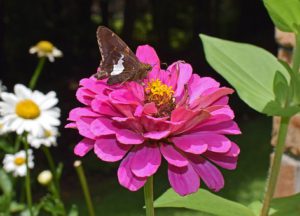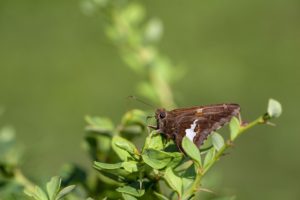Caring for the Silver Spotted Skipper Butterfly

History of sliver spotted skipper butterfly
The silver-skipper is a butterfly of the family Hesperiidae, it’s believed that these butterflies (skippers) are the most recognized and largest in North America. The silver-skipper is found mostly throughout the United States and Southern Canada and has 1-2 generations in the Midwest and increases this number in the Southern part of the US.
The males are said to be territorial and compete to attract females also the males have been known to fly towards moving objects and other flying insects. These butterflies are most common to many butterfly lovers and will have much activity as you make a home for them in your garden and landscape area. Below we will go more in-depth about the life cycle, how to attract them into your garden, and much more.
The silver-spotted skipper butterfly Habitat
The silver-spotted skipper butterfly can be found in urban neighborhoods, open woods, grasslands, and along roadways.
The life cycle of the silver-spotted skipper butterfly
The sliver-skipper has four stages which include.
- Egg
- Larva
- Pupae
- Adult
The female butterfly lays her egg on the underside of the plant leaves, the egg is small and pale in appearance. The egg may also be white, red, or green. Once the larva hatches it begins to feed on the host plant, the larva lives in the leaf shelters. The first instar larva make shelters on the apical leaves halves by using the margin to cut a flap.
The flap is folded over and attach with silk, during this process the larva or caterpillar makes four types of shelters, they leave these shelters to make larger shelters or to feed at nighttime. The caterpillar has a brown head that bears a pair of false orange eggs while their bodies are wrinkle with a green-yellow color.
They may go down into the leaf litter to pupate or within the shelter overwintering, when they emerge in the spring they are now a beautiful butterfly and the cycle starts over again.
Attracting the silver-spotted skipper butterfly to your garden
1. To attract the silver-skipper to your garden you need to install plants that they love some of these plants are. American Wisteria, Phlox ‘Jeane’ Black Locust, Chinese Wisteria, American Hog Peanut, Kudzu, Tall Indigo Bush. However, ensure that the plants you are installing to attract skippers are native to your zone.
2. Install garden plants in an area that gets plenty of sunlight because meeting your garden plants’ requirements will help them to thrive.
3. A water source is so important, filling a shallow dish or two or a bowl will provide the water that they need.
4. A damp area in a part of your garden and a shallow dish with water and sand will provide them with the minerals they need.
5. Adding a few rocks will help in giving them a place to rest when they are not actively moving about.
14 fun facts about the silver-spotted skipper butterfly
1. These butterflies are Wisconsin’s largest.
2. The larva of the silver-skipper butterfly has a segmented body.
3. The silver-skipper hardly visits yellow flowers.
4. The silver-skipper has the resemblances of both a butterfly and a moth.
5. There are more than 3000 species of skippers worldwide.
6. The hinder wings have bands that are metallic white.
7. The sliver-skipper prefers plants that produce purple, red, blue, and pink flowers.
8. The adults use their tongues which are long to extract nectar from garden plants.
9. Their eggs have a lemon yellow color.
10. These butterflies have short hairy bodies.
11. The adult can be found perched upside down under leaves on days when it’s cloudy or hot and at nighttime also.
12. The male sliver-skipper has a thick black line running through the center of their forewing.
13. The hinder wings of the silver-skipper seem to glow.
14. The silver-skipper butterflies have large eyes.
Additional information on the silver-spotted skipper butterfly
1. Don’t use harmful pesticides which can have a negative impact on the silver skipper butterfly.
2. Use mulches around your garden plants to suppress weeds giving the silver-skipper host plant a better chance for survival because weeds compete with garden plants for fertilizer, water, and sunlight.

3. Give your garden plants the right amount of water to keep them growing healthy to accommodate the silver-skipper (food source).
4. The use of beneficial insects by releasing them into your garden or installing plants that will attract them will help in getting rid of garden pests which are also known as biological control.
5. Using harmful pesticides will also kill beneficial insects.
6. Don’t kill caterpillars they may just be the larva of the silver-skipper butterfly.
7. Water garden plants at ground level because wetting the leaves will not only add to water wastage but may knock the larva of plants.
The final word about the silver-spotted skipper butterfly
The sliver-spotted skipper butterfly will do wonders for your garden as it comes to life with their many activities, this is a great way to get involved in wildlife gardening as you watch these amazing butterflies in their natural habitat while helping to bring balance to the ecosystem by providing a home for them so why not consider a garden project of this sort you will be so happy that you did as you are provided with hours of excitement with your garden friends.
About the author
Norman loves being in the garden, both at home and for his job....
he is 'Natures Little helper' being outdoors, growing his vegetables and flowers from an early age.
Now having spent over 22 years in the profession he want to give some of his knowledge to others...
his vast array of hints and tips you will find scattered over this site will help you no end growing plants in your garden.
